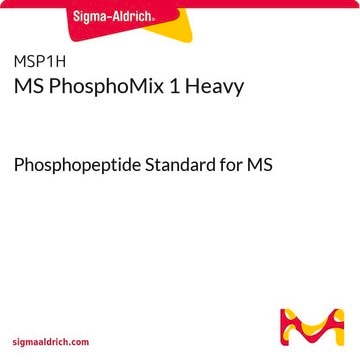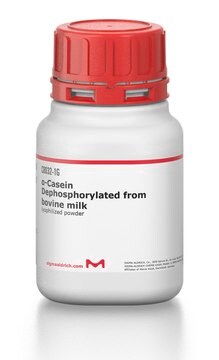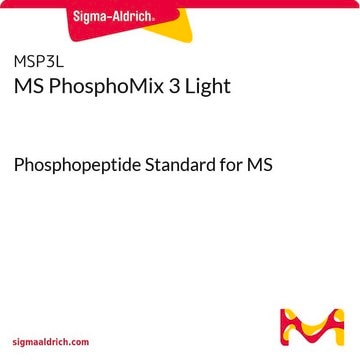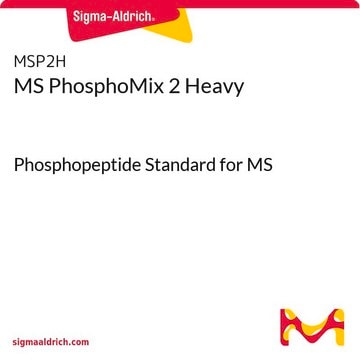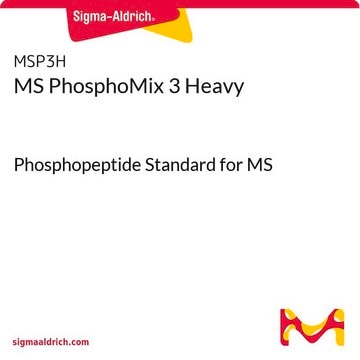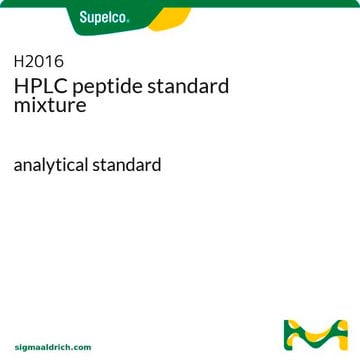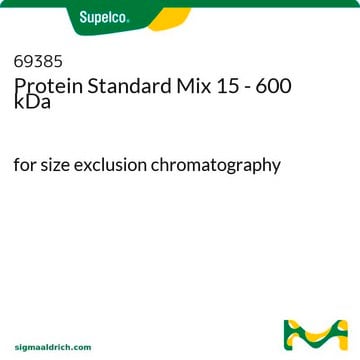MSP2L
MS PhosphoMix 2 Light
Phosphopeptide Standard for MS
Autenticatiper visualizzare i prezzi riservati alla tua organizzazione & contrattuali
About This Item
Codice UNSPSC:
12352200
NACRES:
NA.24
Prodotti consigliati
Qualità
Phosphopeptide Standard for MS
Livello qualitativo
Classi chimiche degli analiti
amino acids, peptides, proteins
Confezionamento
pkg of 200 pmol total phosphopeptides
tecniche
HPLC: suitable
LC/MS: suitable
applicazioni
food and beverages
Formato
multi-component solution
Temperatura di conservazione
−20°C
Categorie correlate
Descrizione generale
The MS PhosphoMix line of products allows for the testing of the strengths and weaknesses of phosphopeptide sample processing, mass spectrometry analysis and instrument configurations. The mixes are produced from synthetic phosphopeptides with sequences derived from naturally occurring peptides as identified by Mann et al. in HeLa cells.† Because the sequences are derived from mammalian cells, many natural phosphorylation motifs, such as those that present an abundance of proline, are represented.† Additionally, the phosphopeptide distribution in each mix has been chosen to present a broad range of characteristics, including ionizability, LC retention time, charge state, and isoelectric point. Finally, PhosphoMix-1, 2, and 3 were designed in a complementary fashion, as highlighted on the following page. For example, all three mixes contain peptides of the same sequence with different sites of phosphorylation.
Each of the three phosphopeptides mixes are available in their naturally occurring isotopic abundances (light) or as stable isotope enriched versions (heavy), making the set of products highly amenable to quantitative analyses, allowing users to compare recovery between workflows or techniques.
More info and FASTA file
Each of the three phosphopeptides mixes are available in their naturally occurring isotopic abundances (light) or as stable isotope enriched versions (heavy), making the set of products highly amenable to quantitative analyses, allowing users to compare recovery between workflows or techniques.
- Naturally occurring peptide sequences
- Broad range of peptide characteristics
- Complementary product designs
- Available in light and heavy versions
More info and FASTA file
Prodotti correlati
N° Catalogo
Descrizione
Determinazione del prezzo
Codice della classe di stoccaggio
11 - Combustible Solids
Classe di pericolosità dell'acqua (WGK)
WGK 3
Punto d’infiammabilità (°F)
Not applicable
Punto d’infiammabilità (°C)
Not applicable
Certificati d'analisi (COA)
Cerca il Certificati d'analisi (COA) digitando il numero di lotto/batch corrispondente. I numeri di lotto o di batch sono stampati sull'etichetta dei prodotti dopo la parola ‘Lotto’ o ‘Batch’.
Possiedi già questo prodotto?
I documenti relativi ai prodotti acquistati recentemente sono disponibili nell’Archivio dei documenti.
Isao Fukuda et al.
Journal of proteome research, 12(12), 5587-5597 (2013-11-20)
Metal oxide affinity chromatography (MOAC) represented by titanium dioxide (TiO2) chromatography has been used for phosphopeptide enrichment from cell lysate digests prior to mass spectrometry. For in-depth phosphoproteomic analysis, it is important for MOAC to achieve high phosphopeptide enrichment efficiency
Dorte B Bekker-Jensen et al.
Nature communications, 11(1), 787-787 (2020-02-09)
Quantitative phosphoproteomics has transformed investigations of cell signaling, but it remains challenging to scale the technology for high-throughput analyses. Here we report a rapid and reproducible approach to analyze hundreds of phosphoproteomes using data-independent acquisition (DIA) with an accurate site
Evgeny Kanshin et al.
Journal of proteome research, 12(6), 2905-2913 (2013-04-24)
Phosphorylation is a reversible protein modification that regulates major cellular processes such as cell division, growth, and differentiation through highly dynamic and complex signaling pathways. Large-scale phosphoproteomics analyses have been greatly facilitated using affinity chromatography such as metal oxide affinity
Daniel Schwartz et al.
Nature biotechnology, 23(11), 1391-1398 (2005-11-08)
With the recent exponential increase in protein phosphorylation sites identified by mass spectrometry, a unique opportunity has arisen to understand the motifs surrounding such sites. Here we present an algorithm designed to extract motifs from large data sets of naturally
Alexander R Ivanov et al.
Proteomics, 13(6), 904-909 (2013-01-16)
Proteomics is a rapidly transforming interdisciplinary field of research that embraces a diverse set of analytical approaches to tackle problems in fundamental and applied biology. This viewpoint article highlights the benefits of interlaboratory studies and standardization initiatives to enable investigators
Il team dei nostri ricercatori vanta grande esperienza in tutte le aree della ricerca quali Life Science, scienza dei materiali, sintesi chimica, cromatografia, discipline analitiche, ecc..
Contatta l'Assistenza Tecnica.
